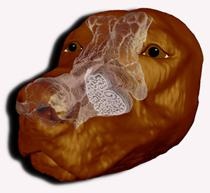Feb 14 2009
For the sensitive work of detecting explosives and drugs in airports and other high-risk areas, humans have long relied on a marvel of evolutionary biology: the sniffer dog. The canine nose can detect a seemingly infinite range of odors, alone and in combination, at concentrations down to the parts per trillion level.
 Three-dimensional computational fluid dynamics model of a canine nose reconstructed from high-resolution MRI scans. Courtesy Eric Paterson
Three-dimensional computational fluid dynamics model of a canine nose reconstructed from high-resolution MRI scans. Courtesy Eric Paterson
But dogs are expensive and time-consuming to train, and some environments are too dangerous for their deployment. As a result, researchers have recently developed a variety of chemical sensing technologies, or artificial noses. So far, though, these devices work only for a limited range or a certain class of chemicals, and are typically stymied by mixtures of chemicals.
A few years ago, with funding from the Office of Naval Research, Eric Paterson, a senior research associate at Penn State's Applied Research Lab and an associate professor of mechanical engineering, decided to go back to the source, studying the fundamental fluid mechanics and odorant transport of canine olfaction with the object of coming up with a better mechanical equivalent.
When a dog sniffs, Paterson explained, odorant-laden air passes through the nasal vestibule and then through a labyrinth of exquisite complexity. This is nature's solution to packing a large surface area in a small volume — crucial for delivering odors to millions of olfactory receptors, specialized proteins embedded in the olfactory epithelium. "Smelling" occurs when odorant molecules bind to these receptors and produce signals that are interpreted by the brain.
To get a closer look at the process, Brent Craven, then a graduate student in mechanical and nuclear engineering, and now an ARL research associate, created a computational fluid dynamics model based on the equations of fluid motion and high resolution magnetic resonance imaging (MRI) of an actual dog's airway.
The model yielded some important insights, Paterson reported. "One key finding was an explanation of how odors were transported to the olfactory region within the nasal cavity. Our computer simulations showed that a single passageway, known as the dorsal meatus, was responsible."
In the olfactory region, the air flow over the mucous-coated receptors is remarkably smooth, "albeit pulsatile due to sniffing," which presents a consistent signal to the receptors. "All of this maximizes efficient transport of odorants to the receptors, and sets up chemical deposition patterns that are interpreted by the brain," Paterson said.
Partly as a result of this work, Paterson and colleagues were chosen this summer as one of three teams to participate in RealNose, a multi-institutional project sponsored by the Defense Advanced Research Projects Agency (DARPA) whose object is to build a mechanical nose that closely simulates the entire canine olfactory system. In addition to Paterson and Craven, the Penn State team includes Gary Settles, director of the Gas Dynamics Lab and Distinguished Professor of Mechanical Engineering, as well as researchers from Tufts University, the University of Pennsylvania, Temple University, the University of Illinois, and the University of Miami. The team, which is led by Evolved Machines, Inc. of Palo Alto, California, also includes industry partners from CogniScent, Inc., of North Grafton, Massachusetts; iSense, Inc. of Champaign, Illinois, and Northrup Grumman.
DARPA's directive outlines four elements in its first phase. First, Paterson says, the team will have to develop an odorant-intake system that incorporates their earlier air-flow and odorant-transport modeling work. Next the team will develop an odorant detection system that incorporates canine olfactory receptors engineered from actual cells. Paterson expects this to be the most challenging part of the project.
"Work needs to be done to identify the receptors that respond to individual chemicals," he explains, "and then these receptors must be expressed in sufficient numbers to be used in an actual sensor." The team is exploring several approaches, one of which involves depositing receptors onto carbon nanomaterials capable of converting scents into electronic signals. A pattern-recognition system would then enable the machine to identify specific odorants in a complex mixture.
As Paterson explains, the RealNose project is a typical "DARPA-hard" program: high-risk, high-payoff. Should marketable technology evolve from the research, however, it could be tailored to sniff out drugs, explosives, chemical and biological weapons, and even certain types of cancer.
"It's fun to find the projects at the seams of different technologies," he says, and Craven agrees. "This is the realm of discovery and unsolved problems. Plus there are practical applications that could positively impact all of our lives."